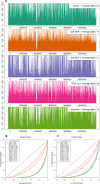Massively parallel sequencing of micro-manipulated cells targeting a comprehensive panel of disease-causing genes: A comparative evaluation of upstream whole-genome amplification methods
- PMID: 29698522
- PMCID: PMC5919401
- DOI: 10.1371/journal.pone.0196334
Massively parallel sequencing of micro-manipulated cells targeting a comprehensive panel of disease-causing genes: A comparative evaluation of upstream whole-genome amplification methods
Abstract
Single Gene Disorders (SGD) are still routinely diagnosed using PCR-based assays that need to be developed and validated for each individual disease-specific gene fragment. The TruSight One sequencing panel currently covers 12 Mb of genomic content, including 4813 genes associated with a clinical phenotype. When only a limited number of cells are available, whole genome amplification (WGA) is required prior to DNA target capture techniques such as the TruSight One panel. In this study, we compared 4 different WGA methods in combination with the TruSight One sequencing panel to perform single nucleotide polymorphism (SNP) genotyping starting from 3 micro-manipulated cells. This setting simulates clinical settings such as day-5 blastocyst biopsy for Preimplantation Genetic Testing (PGT), liquid biopsy of circulating tumor cells (CTCs) and cancer-cell profiling. Bulk cell samples were processed alongside these WGA samples to serve as a performance reference. Target coverage, coverage uniformity and SNP calling accuracy obtained using any of the WGA, is inferior to the results obtained on bulk cell samples. However, results after REPLI-g come close. Compared to the other WGA methods, the method using REPLI-g WGA results in a better coverage of the targeted genomic regions with a more uniform read depth. Consequently, this method also results in a more accurate SNP calling and could be considered for clinical genotyping of a limited number of cells.
Conflict of interest statement
Figures



Similar articles
-
Comparison of whole genome amplification techniques for human single cell exome sequencing.PLoS One. 2017 Feb 16;12(2):e0171566. doi: 10.1371/journal.pone.0171566. eCollection 2017. PLoS One. 2017. PMID: 28207771 Free PMC article.
-
Robust high-performance nanoliter-volume single-cell multiple displacement amplification on planar substrates.Proc Natl Acad Sci U S A. 2016 Jul 26;113(30):8484-9. doi: 10.1073/pnas.1520964113. Epub 2016 Jul 13. Proc Natl Acad Sci U S A. 2016. PMID: 27412862 Free PMC article.
-
The Performance of Whole Genome Amplification Methods and Next-Generation Sequencing for Pre-Implantation Genetic Diagnosis of Chromosomal Abnormalities.J Genet Genomics. 2015 Apr 20;42(4):151-9. doi: 10.1016/j.jgg.2015.03.001. Epub 2015 Mar 14. J Genet Genomics. 2015. PMID: 25953353
-
Whole Genome Amplification in Preimplantation Genetic Testing in the Era of Massively Parallel Sequencing.Int J Mol Sci. 2022 Apr 27;23(9):4819. doi: 10.3390/ijms23094819. Int J Mol Sci. 2022. PMID: 35563216 Free PMC article. Review.
-
Single-Cell Whole-Genome Amplification and Sequencing: Methodology and Applications.Annu Rev Genomics Hum Genet. 2015;16:79-102. doi: 10.1146/annurev-genom-090413-025352. Epub 2015 Jun 11. Annu Rev Genomics Hum Genet. 2015. PMID: 26077818 Review.
Cited by
-
Preimplantation Genetic Testing for Monogenic Disorders.Genes (Basel). 2020 Jul 31;11(8):871. doi: 10.3390/genes11080871. Genes (Basel). 2020. PMID: 32752000 Free PMC article. Review.
-
Genomic Analysis of Circulating Tumor Cells at the Single-Cell Level.J Mol Diagn. 2020 Jun;22(6):770-781. doi: 10.1016/j.jmoldx.2020.02.013. Epub 2020 Apr 2. J Mol Diagn. 2020. PMID: 32247862 Free PMC article.
-
Clinical utility in infants with suspected monogenic conditions through next-generation sequencing.Mol Genet Genomic Med. 2019 Jun;7(6):e684. doi: 10.1002/mgg3.684. Epub 2019 Apr 9. Mol Genet Genomic Med. 2019. PMID: 30968598 Free PMC article.
-
Differential performance of strategies for single-cell whole-genome amplification.Cell Rep Methods. 2025 Apr 21;5(4):101025. doi: 10.1016/j.crmeth.2025.101025. Cell Rep Methods. 2025. PMID: 40262527 Free PMC article.
-
Single-Circulating Tumor Cell Whole Genome Amplification to Unravel Cancer Heterogeneity and Actionable Biomarkers.Int J Mol Sci. 2022 Jul 29;23(15):8386. doi: 10.3390/ijms23158386. Int J Mol Sci. 2022. PMID: 35955517 Free PMC article. Review.
References
-
- Zegers-Hochschild F, Adamson GD, Dyer S, Racowsky C, de Mouzon J, Sokol R, et al. The International Glossary on Infertility and Fertility Care, 2017†‡§. Hum Reprod. 2017. September 1;32(9):1786–801. doi: 10.1093/humrep/dex234 - DOI - PMC - PubMed
-
- Deleye L, Dheedene A, De Coninck D, Sante T, Christodoulou C, Heindryckx B, et al. Shallow whole genome sequencing is well suited for the detection of chromosomal aberrations in human blastocysts. Fertil Steril. 2015. November 1;104(5):1276–1285.e1. doi: 10.1016/j.fertnstert.2015.07.1144 - DOI - PubMed
-
- Fiorentino F, Biricik A, Bono S, Spizzichino L, Cotroneo E, Cottone G, et al. Development and validation of a next-generation sequencing-based protocol for 24-chromosome aneuploidy screening of embryos. Fertil Steril. 2014. May 1;101(5):1375–1382.e2. doi: 10.1016/j.fertnstert.2014.01.051 - DOI - PubMed
-
- Wells D, Kaur K, Grifo J, Glassner M, Taylor JC, Fragouli E, et al. Clinical utilisation of a rapid low-pass whole genome sequencing technique for the diagnosis of aneuploidy in human embryos prior to implantation. J Med Genet. 2014. August 1;51(8):553–62. doi: 10.1136/jmedgenet-2014-102497 - DOI - PMC - PubMed
-
- Dreesen J, Destouni A, Kourlaba G, Degn B, Mette WC, Carvalho F, et al. Evaluation of PCR-based preimplantation genetic diagnosis applied to monogenic diseases: A collaborative ESHRE PGD consortium study. Eur J Hum Genet. 2014. August 4;22(8):1012–8. doi: 10.1038/ejhg.2013.277 - DOI - PMC - PubMed
Publication types
MeSH terms
Substances
LinkOut - more resources
Full Text Sources
Other Literature Sources
Miscellaneous

